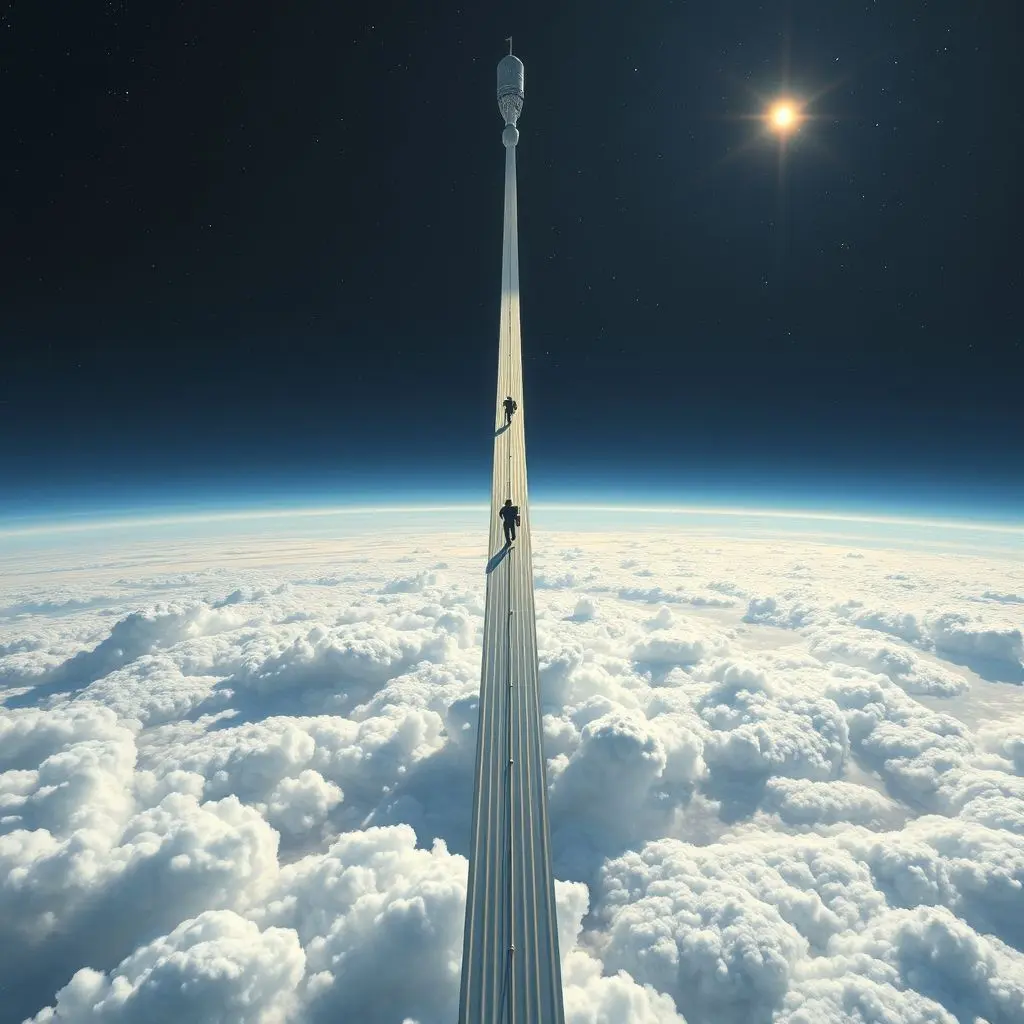Imagine stepping into an elevator here on Earth and simply riding it… all the way to space. No fiery rockets, no bone-jarring acceleration, just a smooth, silent ascent into the cosmos. This isn’t just the stuff of science fiction novels or futuristic movies; it’s the intriguing, ambitious concept of a space elevator.
Sounds absolutely wild, right? A giant ribbon stretching thousands upon thousands of miles from the ground up to an anchor in geostationary orbit, held taut by cunning physics and a massive counterweight? It’s the ultimate vertical highway, promising potentially revolutionary access to space that could dramatically slash costs compared to today’s launch methods.
But how close are we really to building such a marvel? Is it a tangible future project or will it forever remain a tantalizing ‘what if’ confined to our imaginations and the silver screen? We dive deep into this colossal idea below.
Table of Contents
Unveiling the Space Elevator Concept
At its heart, a space elevator system consists of several key components:
- The Tether: An incredibly long, strong cable or ribbon, extending from an anchor point on Earth (likely in the ocean near the equator) up into space. Its length would be around 62,000 miles (100,000 kilometers) – far beyond geostationary orbit (approx. 22,236 miles or 35,786 km) – to allow the counterweight to provide the necessary tension.
- The Counterweight: Positioned at the far end of the tether beyond geostationary orbit. Its centrifugal force, resulting from matching the Earth’s rotation speed at that height, pulls outward, counteracting gravity’s pull on the lower sections of the tether and keeping it taut. Think of it like spinning a weight on a string – the weight wants to fly outward.
- The Anchor: A mobile platform or base on Earth, likely a ship, capable of maneuvering to avoid weather and space debris.
- Climbers: Robotic (or eventually human-carrying) vehicles that ascend and descend the tether, carrying payloads or passengers. These would likely be powered electrically, drawing energy beamed from the ground or harvested along the way.
The principle relies on the balance between Earth’s gravity pulling the lower part of the tether down and the centrifugal force pulling the upper part (and counterweight) outward. At geostationary orbit, a point is reached where an object orbiting at that altitude stays above the same spot on Earth. The elevator’s components at that height also match this speed, contributing to the system’s stability.

Just how revolutionary could this be? Consider the current method of reaching orbit: rockets. They are powerful, complex, and require immense amounts of fuel just to get off the ground, most of which is discarded along the way. Each launch is a one-off, expensive event. A space elevator, in theory, would be a permanent piece of infrastructure, allowing for continuous, relatively gentle, and far cheaper trips to space once built.
Watch: Riding the Elevator to the Stars Idea!
Speaking of this incredible concept, check out this quick dive into the space elevator idea we put together. It gives you a brief visual and audio tour of this potential future marvel and the massive challenges it faces.
The Colossal Challenges: Why We Don’t Have One Yet
So, if the concept is so promising, why isn’t construction already underway? The short answer is: physics and engineering haven’t quite caught up to the dream. The hurdles are monumental.
The Material Problem: Stronger Than Anything Ever Made
This is arguably the single biggest showstopper right now. The tether material must possess an unimaginable tensile strength – the ability to withstand being pulled apart. Steel, carbon fiber, Kevlar – common strong materials – wouldn’t even come close to supporting their own weight over such immense distances, let alone carrying a payload.
Scientists calculate the material needs to have a tensile strength measured in Gigapascals (GPa) that is orders of magnitude higher than steel (which is around 0.4-0.8 GPa). Theoretical materials like perfect carbon nanotubes, boron nitride nanotubes, or graphene ribbons exhibit the *potential* for the required strength (estimated in the tens, or even hundreds, of GPa), but manufacturing these materials in the required lengths (tens of thousands of miles!), uniform quality, and sufficient quantity is far beyond our current capabilities.

Engineering on an Unprecedented Scale
Even if we had the material, the engineering required is mind-boggling. How do you deploy a 62,000-mile ribbon into space? It couldn’t be built from the ground up (it would collapse). The likely scenario involves launching a very strong, relatively lightweight initial tether segment, perhaps using rockets, deploying it outwards to geostationary orbit and beyond, and then lowering the other end towards Earth while simultaneously strengthening and widening the tether by sending up more material via early climbers.
Maintaining stability is another issue. The tether would be subject to vibrations, Earth’s atmosphere (weather, winds), and potentially orbital debris or meteoroids. Developing systems to detect, avoid, or withstand impacts would be crucial.
The Astronomical Cost
Estimates vary wildly, but the initial investment in a space elevator would be in the hundreds of billions, if not trillions, of dollars. This includes material production, deployment infrastructure, climber development, and ongoing maintenance and risk mitigation systems. While the cost per kilogram to orbit would plummet *after* construction, the upfront cost is a significant barrier.
Safety and Security
A single point of failure: the tether. A break could have catastrophic consequences, potentially raining thousands of miles of cable down onto the Earth’s surface, not to mention the loss of the system and any climbers on it. Protecting the tether from deliberate attack, accidents, or the harsh space environment is paramount.

Dream vs. Reality: Where Do We Stand?
Despite the immense challenges, research continues globally. Organizations like the International Space Elevator Consortium (ISEC) actively study the technical feasibility, explore potential materials, and hold conferences to advance the concept. While we are still decades, perhaps even a century, away from seeing a space elevator rise, the fundamental physics holds true.
Advancements in nanotechnology and material science, particularly in the realm of carbon structures, bring the required tether strength slightly closer to the realm of possibility with each passing year. Engineering challenges, while vast, are often solved through persistent innovation and resources.
Frequently Asked Questions
Got more questions about this futuristic transport system? Here are some common ones:
Is a space elevator held up by gravity or pushing off the ground?
Neither, in the way you might first think. It’s held taut by a balance of forces. Earth’s gravity pulls the lower part down, while the centrifugal force from the rotating counterweight (which is orbiting faster than needed at its height) pulls the upper part outward. The tether is essentially suspended between these opposing forces, under incredible tension.
How fast would a climber travel up the tether?
Speeds are theoretical but would need to be relatively slow compared to a rocket launch to minimize stress on the tether and power requirements. Estimates vary, but journeys could take several days to reach geostationary orbit.
What about power for the climbers?
One leading idea is beaming energy, perhaps via lasers or microwaves, from the ground station up to photovoltaic receivers on the climbers. Other concepts involve conductive tethers or onboard power generation, but beamed energy is often considered the most viable.
Could space debris or meteoroids break the tether?
This is a significant risk. The tether would need to be designed with redundancy (perhaps multiple strands) and advanced systems for detecting and potentially dodging larger objects. Micrometeoroids and smaller debris could cause erosion over time, requiring continuous repair or strengthening.
Looking Towards the Horizon
The space elevator remains one of humanity’s most ambitious engineering concepts. It embodies a leap in thinking about how we interact with space, promising a future where accessing orbit is routine and affordable, opening up new possibilities for exploration, research, and industry beyond Earth.
While the hurdles of material science, engineering complexity, and cost are immense, they are not necessarily insurmountable with sufficient time, resources, and continued technological progress. For now, the space elevator might reside primarily in the realm of science fiction, but it serves as a powerful inspiration and a tangible goal driving innovation in fields like advanced materials and mega-scale engineering. The dream of a smooth ride to the stars continues to pull us forward.





